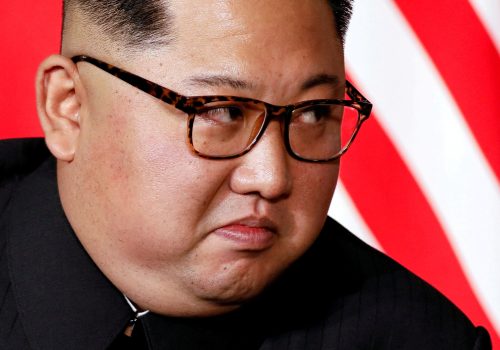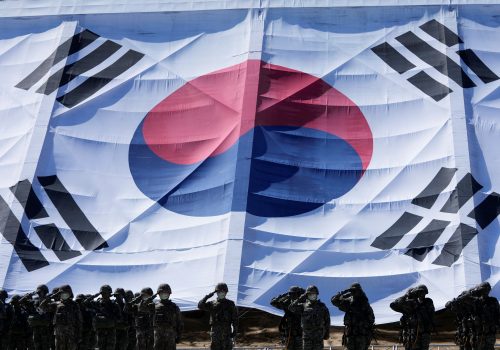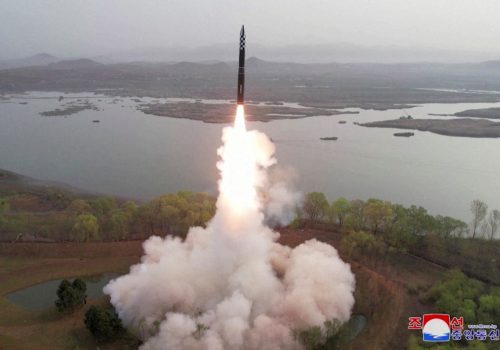Experts react: South Korea embarks on a new nuclear era. How will it play out?
When it comes to nuclear-related events, the Korean Peninsula this week resembled an atom’s nucleus, from which the adjective nuclear derives. It was a charged center of activity. On Tuesday, US and South Korean officials gathered in Seoul for the inaugural meeting of the Nuclear Consultative Group (NCG), a new bilateral platform coming out of April’s Washington Declaration to coordinate deterrence against a North Korean nuclear attack, including with US nuclear weapons. The same day, a US nuclear submarine docked at a South Korean port for the first time since 1981, even as North Korea continues to launch missiles and claim tensions are escalating “to the brink of nuclear war.” Throw in the curious case of a US soldier crossing from South Korea to North Korea, and it’s been an explosive week.
Below, Atlantic Council experts explain what happened and what to expect next.
Click to jump to an expert analysis:
Markus Garlauskas: Success will require reaching beyond the officials in the NCG
Robert M. Soofer: On the agenda was the unthinkable—what to do if deterrence fails
Bee Yun Jo: The NCG was a success, even if it didn’t address all of South Korea’s security concerns
Thomas Cynkin: Would the US trade Los Angeles for Seoul? South Koreans want to know.
Ryo Hinata-Yamaguchi: Watch what impact the NCG will have on Japan
Success will require reaching beyond the officials in the NCG
The inaugural meeting of the US-South Korea NCG is an important step in improving the assurance of South Korea, deterrence of North Korea, and the alliance’s military response capability. That senior representatives from the White House and South Korea’s presidential office led the delegations should signal the importance both sides place on following through with the Washington Declaration and set the stage for robust follow-through. However, the NCG’s engagement outside of high-level government channels may be even more pivotal to its success going forward.
The brief joint readout set out an ambitious and logical agenda of quarterly meetings to advance on several workstreams, which include some very practical measures focused not just on reassuring South Korea, but also on improving deterrence of and responses to a North Korean nuclear attack. Such a brief public readout, of course, cannot capture the full scope and detail of what has been and will be discussed at NCG meetings. Such meetings will inevitably touch upon issues that are politically sensitive, involve classified operational and intelligence information, or both. The unfortunate tendency by some South Korean and US officials, as a result, will be to keep the proceedings very “close hold” and the public readouts very brief and selective. Meanwhile, issues deemed too politically sensitive by one or both sides might not even make it on the agenda, for fear of derailing the meetings or that such discussions might leak to the press. Such an approach would not be helpful for the NCG’s goals.
The United States and South Korea should be as forthcoming as possible about the results of NCG discussions in future sessions, and they should engage outside experts extensively in a broader effort to advance the NCG’s workstreams. The benefits of such an approach, if executed, will outweigh the risks. The NCG’s proceedings should take a cue from Director of National Intelligence Avril Haines’s latest efforts on transparency, including the wise and bold step of publicly releasing the recent National Intelligence Estimate on North Korea. Ultimately, exchanging insights with a wider group of experts in parallel with official NCG meetings will help to reassure more South Koreans across the political spectrum, aid in getting the message to North Korean elites, and help to make the best use of the capabilities of government and nongovernment experts inside South Korea and the United States to achieve the NCG’s objectives.
—Markus Garlauskas led the US intelligence community’s strategic analysis on North Korea as the national intelligence officer for North Korea, after serving as the chief strategist at the US-South Korea Combined Forces Command. He is the director of the Indo-Pacific Security Initiative at the Scowcroft Center for Strategy and Security of the Atlantic Council, and tweets at @Mister_G_2.
On the agenda was the unthinkable—what to do if deterrence fails
The North Korean intercontinental ballistic missile (ICBM) test just days prior to the inaugural meeting of the NCG must have been a poignant reminder to the participants about why they were there. North Korean belligerence and the expansion of its nuclear arsenal have been sowing doubts among South Koreans about the reliability of the US nuclear umbrella. The purpose of the NCG is for the United States to satisfy its ally that it has the capabilities and the resolve to counter North Korean nuclear threats—and that Washington will take South Korean security interests into account when deciding how and when to use nuclear weapons.
On the agenda for the meeting were discussions about measures, some already in place, to share information on the nuclear threat, improve understanding about the role of nuclear weapons, and think through the unthinkable: what to do if nuclear deterrence fails and the United States and its allies are forced to respond to an initial North Korean nuclear use. Perhaps more important than the exchange of information was the establishment of protocols and processes for consultation between the two countries during crisis and conflict.
The nuclear dimension of any conflict will be unique, and how the United States responds will depend on the president and the circumstances (including the concerns of allies), regardless of preexisting plans. South Korean officials should appreciate this when they request ever-more detailed briefings of US nuclear plans that the Department of Defense does not provide even, for example, to its NATO allies. Tabletop exercises examining how the two sides could react after nuclear use are foundational, as are exercises conducted by US nuclear forces with potential South Korean conventional support.
Visits to South Korean ports by US nuclear submarines and overflights by US strategic bombers may not fully address the underlying security dilemma for South Korea, which is whether the United States would be willing to run the risk of North Korean nuclear retaliation against a homeland that is becoming increasingly vulnerable to Pyongyang’s long-range missiles. The United States today is protected against North Korean ICBMs due to the US national missile defense system, which should put South Koreans at ease. But the future of US homeland defense must share space in future NCG agendas along with nuclear and integrated strategic deterrence more broadly.
—Robert M. Soofer is a senior fellow in the Forward Defense practice of the Atlantic Council’s Scowcroft Center for Strategy and Security, where he leads its Nuclear Strategy Project.
The NCG was a success, even if it didn’t address all of South Korea’s security concerns
The inaugural NCG meeting was a success, highlighting substantial developments in combined efforts to thicken the United States’ nuclear umbrella. First of all, the meeting afforded a visible reaffirmation of the United States’ commitment to provide a full range of US capabilities, including nuclear. Along with reaffirmed words of commitment in the joint readout to “a swift, overwhelming, and decisive response” against “any nuclear attack by North Korea,” the United States and South Korea succeeded in coordinating the first port call of a US nuclear submarine in four decades.
The NCG meeting was also successful in conveying the seriousness to both the South Korean and US governments in the implementation of the new bilateral consultations. Upgrading the first meeting to be held at deputy-level, South Korean President Yoon Suk Yeol also made a brief appearance at the beginning of the meeting. Reifying the Washington Declaration, the first NCG meeting laid out concrete steps, including the development of security and information sharing protocols, nuclear consultation and communication processes for contingencies, and the development of joint planning, operations, exercises, simulations, trainings, and investment activities, particularly on the execution of South Korea’s conventional support to the United States’ nuclear operations.
Lastly, the NCG meeting reasserted South Korea’s commitment in nonproliferation. As Kim Tae-hyo, Seoul’s principal deputy national security adviser, stated during the joint press briefing, “There is no need for South Korea to consider separate nuclear armament.”
What the first NCG meeting achieved may not fully address South Korea’s security concerns. Disappointments and criticisms can be swift and easy. Yet, an important caveat here is that the Washington Declaration and implementation of the NCG rest on the conviction of the “importance, necessity, and benefit” of enduring maintenance of the United States’ nuclear umbrella. The implementation of the NCG and strengthening of the United States’ nuclear umbrella have succeeded in taking South Korea’s nuclear path again off the table. The combined efforts derive not from naïveté about an impermeable nuclear umbrella, but from realistic assessments on the risks, if not infeasibility, of South Korea’s nuclear path.
—Bee Yun Jo is a nonresident senior fellow in the Indo-Pacific Security Initiative at the Atlantic Council’s Scowcroft Center for Strategy and Security and an associate research fellow in the Defense Strategy Division at the Center for Security and Strategy at the Korea Institute for Defense Analyses.
The US and South Korea doubled down on ending the Kim regime if it uses nuclear weapons
A US soldier’s crossing into North Korea and subsequent detainment significantly complicates matters for the US-South Korea alliance and a Korean Peninsula that is experiencing a precarious ratcheting up of tensions. The soldier’s crossing comes amid South Korean and US efforts to strengthen deterrence through its new NCG, and it follows North Korea’s most recent launching of an ICBM. As this situation unfolds, the US-South Korea alliance will have to face the delicate balancing act of strengthening deterrence and assuaging tensions while also hoping to renew dialogue. Notably, despite the NCG and the deployment of the USS Kentucky nuclear submarine being planned for months, media coverage tied the events to North Korea’s missile launch rather than tying alliance actions to the evolution of Pyongyang’s capabilities. Thus, alliance actions pose the risk of being interpreted as retaliatory and escalatory if not properly communicated.
What was also notable about the NCG readout was the alliance’s doubling down on the threat to end the Kim regime in the event of any North Korea nuclear use. This would have to mean that the alliance intends to possibly further escalate a conflict even in the event of North Korean low-yield nuclear use. By making this threat, the alliance restricts its freedom of maneuver to de-escalate a conflict.
While the US-South Korea alliance at this time likely intends to make good on that threat, it is questionable whether this promise will hold for subsequent US and South Korean administrations. Polarization in both US and South Korean politics make for a questionable trajectory as both countries have pivotal elections in 2024. South Korea’s legislative election in April 2024 has the potential to significantly derail Yoon’s ability to further his foreign policy approach toward North Korea and strengthen the alliance. If the left-leaning Democratic Party of Korea were to, for instance, gain a supermajority (as they did in 2020), then it’s likely that the party will move to thwart Yoon’s approach to North Korea for the remainder of his one-term presidency.
Likewise, the outcome of the US presidential election is far from certain. The election has the potential of leading to another Trump administration or an administration with similar views about alliances. Notably, there has been diminishing support among US Republicans for NATO over the course of Russia’s invasion of Ukraine. This phenomenon will likely further international concerns surrounding the endurance of other US alliance commitments, particularly amid potential conflict escalation scenarios.
But in the near term, we are likely to see an increasingly recalcitrant North Korea amid US-South Korean efforts to strengthen the alliance. Ahead of the seventieth anniversary of the Korean War armistice on July 27, a robust US-South Korea military exercise schedule, and the 2024 elections in South Korea and the United States, and with the complication of a US citizen now detained in North Korea, Pyongyang is unlikely to be swayed to change course without substantial concessions on the US-South Korea side. Both Seoul and Washington will likely vehemently oppose any such concessions ahead of their elections.
—Jessica Taylor is a nonresident fellow in the Indo-Pacific Security Initiative at the Atlantic Council’s Scowcroft Center for Strategy and Security. Taylor has served in the US Department of Defense in both military and civil service capacities for nearly twenty years.
Would the US trade Los Angeles for Seoul? South Koreans want to know.
The Washington Declaration, which reaffirmed the strength of the US nuclear umbrella covering South Korea, was further reinforced this week with strong signals in the form of the NCG and a rare and highly visible port visit by a US nuclear submarine to South Korea. While these moves were welcome, they did not represent a significant shift in US policy. Rather, they were a more concrete and visible manifestation of existing US extended deterrence policy and related US-South Korea strategic stability consultations. They were aimed as much at building confidence among the South Korean public in the US nuclear deterrent—and ameliorating domestic pressure within South Korea to “go nuclear”—as at deterring North Korean aggression.
With the growth of the North Korean nuclear weapons program, now comprising enough fissile material for an estimated forty-five-to-fifty-five nuclear weapons and an expanding arsenal of missiles, North Korean capability to hold US cities at risk is increasing and the credibility of the US strategic deterrent is concomitantly being corroded. French President Charles de Gaulle famously asked US President John F. Kennedy whether the United States would trade New York for Paris. Similarly, Yoon and the South Korean public must be questioning whether the United States would trade Los Angeles for Seoul. Exercises in confidence building are useful but insufficient to resolve such doubts.
Moreover, deterring a North Korean attack is critical but not the only issue. North Korea’s capacity to sell nuclear materials, missiles, components, or even nuclear weapons poses a grave proliferation threat. Also, as the North Korean nuclear threat continues to grow, so will the pressure on regional countries, including South Korea, to go nuclear themselves. While the Washington Declaration and connected developments are a useful step, they are no substitute for a fundamental review of existing US strategy to actively contain North Korea in the face of the shifting strategic balance of forces on the Korean Peninsula.
—Thomas Cynkin is a nonresident senior fellow in the Indo-Pacific Security Initiative at the Atlantic Council’s Scowcroft Center for Strategy and Security and the practice lead, Japan and Northeast Asia, of the Transnational Strategy Group, a global consulting firm operating at the nexus of policy and business.
Watch what impact the NCG will have on Japan
The inaugural NCG meeting focused much on confirming the details of how the group will operate, including the formation of workstreams to make the United States and South Korea more effective in their deterrence and response readiness against the threat posed by North Korea. The meeting was also packaged well to express the United States’ strong bilateral commitment to extended deterrence, timed with the port call by the USS Kentucky to Busan.
Indeed, there is still much to see regarding the actual effects produced going forward, which pivots on how the United States and South Korea operationalize and execute the workstreams to prove that the NCG is essential, effective, and mutually beneficial. Moreover, there are also questions concerning the group’s sustainability considering the delicate domestic politics—particularly in South Korea, where the strategic debates and security dilemmas are still real. Should the NCG prove to be merely symbolic, this could very well boost the arguments for indigenous nuclear armament in South Korean.
Another key area to watch going forward will be the impact the NCG has on Japan. While the NCG has to focus on making the bilateral framework effective, the continuously growing nuclear threats in the region and any proven success of the NCG will underscore the need to expand the group to a trilateral framework, or at the very least to establish a separate US-Japan NCG.
—Ryo Hinata-Yamaguchi is a nonresident senior fellow in the Indo-Pacific Security Initiative, an assistant professor at the University of Tokyo, and a research fellow at Pacific Forum.
Further reading
Wed, Jun 28, 2023
Reading between the lines of the new North Korea intelligence estimate
New Atlanticist By Markus Garlauskas
The US intelligence community has just released its National Intelligence Estimate on North Korea, a watershed analysis. But more is worth adding to the discussion.
Sat, May 20, 2023
Don’t call it a Quint, but South Korea does have a future with the Quad
New Atlanticist By Thomas Cynkin
There is space for South Korea to participate in aspects of the Quadrilateral Security Dialogue and other minilateral structures aimed at maintaining international order and security in the Pacific.
Thu, Apr 27, 2023
Not every North Korean missile needs a response. South Korea and the US should focus more on readiness and deterrence.
New Atlanticist By Jessica Taylor
The nuclear collaboration announced by the US and South Korean presidents this week is the type of strategic measure the allies need to focus on, rather than a reactive approach.
Image: US National Security Council Coordinator for Indo-Pacific Affairs Kurt Campbell speaks as Principal Deputy National Security Adviser Kim Tae-hyo looks on during a press conference at the Presidential Office in Seoul, South Korea, July 18, 2023.


